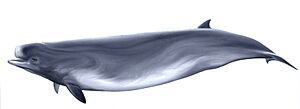Southern bottlenose whale facts for kids
Quick facts for kids Southern bottlenose whale |
|
|---|---|
 |
|
 |
|
| Size compared to an average human | |
| Conservation status | |
| Scientific classification | |
| Genus: |
Hyperoodon
|
| Species: |
planifrons
|
 |
|
| Southern bottlenose whale range | |
The southern bottlenose whale (Hyperoodon planifrons) is a special type of whale. It belongs to a group called beaked whales. These whales are rarely seen because they live in the deep, cold waters around Antarctica.
An English zoologist named William Henry Flower first described this whale in 1882. He studied a skull found on Lewis Island, in Western Australia. Southern bottlenose whales live in very deep ocean waters, often more than 1,000 meters (about 3,300 feet) down!
Contents
About the Southern Bottlenose Whale
The southern bottlenose whale can grow up to 7.5 meters (about 25 feet) long when it's fully grown. This makes it smaller than its cousin, the northern bottlenose whale.
Its beak, which is like a long nose, is white in males and grey in females. The fin on its back, called the dorsal fin, is quite small. It's about 30–38 centimeters (12–15 inches) tall. This fin is shaped like a sickle and is usually pointed.
The whale's back is light to medium grey, and its belly is lighter. Scientists are still learning if their colors change based on where they live or if each whale has its own unique coloring.
Where Southern Bottlenose Whales Live
Southern bottlenose whales live all around the Southern Ocean. This means you can find them in a wide circle around the South Pole.
They live as far south as the coast of Antarctica. They can also be found further north near the tip of South Africa, around New Zealand's North Island, and in the southern parts of Brazil.
Sometimes, whales that look similar are seen in warmer, tropical waters. However, these are usually a different species called Longman's beaked whale, not the southern bottlenose whale.
How Southern Bottlenose Whales Behave
Southern bottlenose whales are amazing divers! They can hold their breath and dive for 15 to 40 minutes. This is a very long time compared to many other whales.
They usually swim in small groups, with only 1 to 5 whales together. Their main food is squid and krill. Scientists have studied what these whales eat by looking at their stomach contents. They found that the whales mostly eat squid from the Antarctic, but also some from South Africa.
How Many Whales Are There?
It's hard to know exactly how many southern bottlenose whales there are in the world. Scientists don't have a clear number for their total population.
However, studies in the Antarctic circle have shown that southern bottlenose whales make up more than 90% of all the beaked whale sightings there. This suggests they are quite common in those waters.
Dangers to Southern Bottlenose Whales
In the past, the biggest danger to southern bottlenose whales was whaling. This means they were hunted by people.
Some whales were caught by Soviet whalers for research. Japanese whalers also caught a number of these whales. Luckily, whaling has been greatly reduced.
Protecting Southern Bottlenose Whales
Good news for these whales! In 1994, the International Whaling Commission (IWC) created a special whale sanctuary in the Southern Ocean. This sanctuary made it against the rules to hunt whales in that area.
The southern bottlenose whale is also protected by an agreement called the Memorandum of Understanding for the Conservation of Cetaceans and Their Habitats in the Pacific Islands Region (Pacific Cetaceans MOU).
Currently, the IUCN (International Union for Conservation of Nature) lists the southern bottlenose whale as "Least Concern." This means they are not currently at high risk of extinction.
See also
- List of cetaceans


